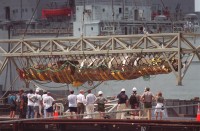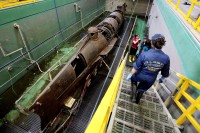 The U.S. Navy has released a comprehensive archaeological report on the recovery of the Confederate submarine H.L. Hunley and it is a total page-turner.
The U.S. Navy has released a comprehensive archaeological report on the recovery of the Confederate submarine H.L. Hunley and it is a total page-turner.
The Hunley sank off of Charleston Harbor on February 17th, 1864, but not before taking down its target, the USS Housatonic, in the first successful torpedoing of a ship by a submarine. Famous for this feat and for its disappearance immediately after the clash, the wreck of the Hunley was much sought by scholars, archaeologists and an adventure novelist. After decades of scholarship and fruitless searches, it was the novelist, Clive Cussler, with a team of experts from the National Underwater and Marine Agency (NUMA), who found the wreck in 1995. It was tilted on its starboard side, embedded in the seabed at a 45 degree angle and buried under feet of silt.
The idea of raising the hand-cranked iron submarine that played such a seminal role in the development of naval technology was a daunting one. It had been protected for 131 years by its silten blanket, and any excavation could endanger the sub. If it survived being dug out, then it would have to be safely raised out of the water, a logistical challenge of massive proportions. But the incentives to take the plunge were strong. Unlike other shipwrecks, Hunley almost certainly had sealed compartments that contained not just untouched artifacts, but the remains of the eight brave crewmen who operated this terrifying contraption. With the news of the discovery making headlines all over the country, the wreck would certainly become the target of looters.
 Five years passed from discovery to recovery, five years of assiduous research, planning and problem-solving. You don’t have to be Civil War or naval history buff to find the Navy’s report on the recovery project riveting. It covers so much ground that anyone with an interest in archaeology, conservation, science, engineering, metallurgy, museums, even project management will be fascinated. I’ve read a lot of archaeological reports over the years, but I’ve never read one this thorough. It goes into depth on the historical background of Hunley, including its predecessors, recovery attempts after the war and searches in the 20th century. It’s not just verbiage, either. There is a plethora of pictures, maps and diagrams.
Five years passed from discovery to recovery, five years of assiduous research, planning and problem-solving. You don’t have to be Civil War or naval history buff to find the Navy’s report on the recovery project riveting. It covers so much ground that anyone with an interest in archaeology, conservation, science, engineering, metallurgy, museums, even project management will be fascinated. I’ve read a lot of archaeological reports over the years, but I’ve never read one this thorough. It goes into depth on the historical background of Hunley, including its predecessors, recovery attempts after the war and searches in the 20th century. It’s not just verbiage, either. There is a plethora of pictures, maps and diagrams.
Dr. Michael McCarthy of the Western Australia Museum, who participated in a 1999 symposium of experts convened to discuss the recovery of H.L. Hunley, puts it beautifully in the foreword:
[This report] ably brings to the world the complexity of such a multi-faceted project, its own history, including the search and finding, the engineering problems and solutions, the archaeology, conservation, historical research, public access, and future exhibition plans. Clearly evident is the fact that it has all required perseverance, dedication, and exceptional time management from not only the archaeologists, researchers, and conservators, but those who managed the funding and the enormous resources required to complete the project. What editors Robert Neyland and Heather Brown have brought together and presented in what follows is a fitting and lasting tribute to the project’s many and various constituents and, like H.L. Hunley itself, it is a monument to its builder and to its three brave crews, young men once lost and now known to all.
The 321-page document can be downloaded free of charge in pdf format here.
Were any remains found in the hull? Whatever their cause, the men who crewed that thing were heroes of thed first rank. The courage of the early morning indeed!
Remains found in the hull? – As in most of those cases, it was all still there. One of my grandpa’s friends, however, was allegedly downed several(!) times in German submarines during WWII, but most of what he told to us kids in his later years, almost certainly, was -let’s face it- simply tall told sailor’s yarn. I could not even imagine how escape from a war sub hull might have worked.
The crew was buried with proper ceremony. Friends of the Hunley describes it http://hunley.org/main_index.asp?CONTENT=CREWB
Here is a good read on the recovered remains, and what may have caused Hunley to sink – http://futureforce.navylive.dodlive.mil/2014/10/how-did-hunleys-crew-die/
As to escaping from a war sub, the story of the US fleet submarine Squalus is a fascinating one, though it did not sink due to battle damage.
Working my way through the report now but I’m only like 25% of the way in.
What a horrifying craft to sign up for- it sank and trapped all its crew, was raised a month later (what a mess that must have been to clean up inside), sank /again/ and killed most of its crew, and then they raised it a second time and still managed to sign up a third crew to crank it around in the hopes of achieving something (and hopefully even surviving also).
According to Grandma, the only survivor, their poor friend in his German submarine was indeed hit on two occasions during WWII.
According to her, both incidents happened in Italy, while clearing for mines.